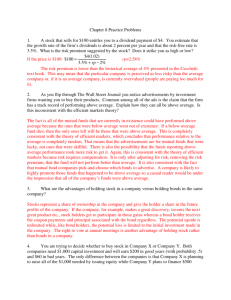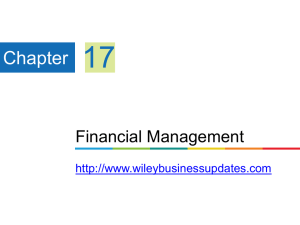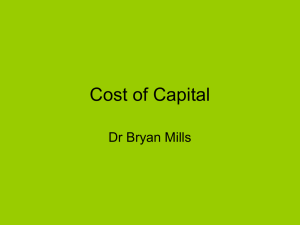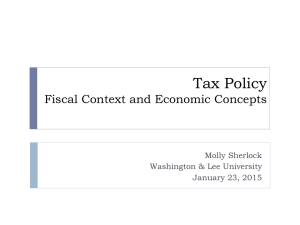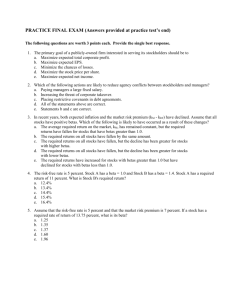Corporate Finance The Project
advertisement
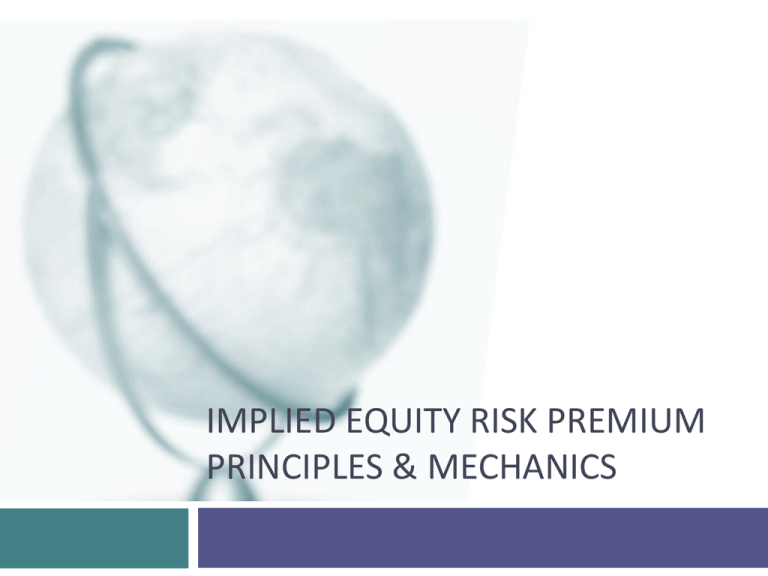
IMPLIED EQUITY RISK PREMIUM PRINCIPLES & MECHANICS The core idea Watch what I pay, not what I say The price that investors pay for risky assets is the key indicator of their desired risk premium on that risky asset. Put simply, if you want a higher risk premium from a risky asset (or class), you will pay a lower price today. If you want a lower risk premium, you will pay a higher price. Thus, if I know the price paid for a risky asset and can estimate the expected cash flows on that asset, I can back into the expected return that investors are demanding from that asset. Subtracting out the risk free rate will give me an (implied) equity risk premium. 2 Here is the simplest case: Stock with perpetual, constant but uncertain dividend The value of a stock that pays out a perpetual, constant dividend is as follows: Value of stock = Dividend/ Cost of equity Cost of equity = Dividend/ Value of stock = Dividend Yield ERP = Dividend yield – Riskfree rate It is true that you would not buy stocks if all you were promised was today’s cash flow in perpetuity. So, this is unrealistic, but it is still a limiting case 3 Stock with a dividend expected to grow at constant rate forever This, of course, is the stock that the classic Gordon growth model values: Value of stock = Expected Dividend next year/ (Cost of equity – Expected growth rate) Cost of equity = Dividend Yield + Expected growth rate ERP = Cost of equity – Riskfree Rate If we assume that the riskfree rate = expected growth rate in perpetuity, this simplifies: ERP = Dividend yield 4 When companies grow and earn no excess returns.. If we assume that companies grow but that they earn no excess returns, the value of a stock can be written purely as a function of its earnings: Value of Stock = Earnings/ Cost of equity Cost of equity = Earnings/ Value of stock ERP = Earnings Yield – Risk free rate This is the basis for the short cut that some analysts use for the cost of equity but it works only if there are no excess returns. 5 Generalizing to any scenario Assume that companies do not always pay out what they can afford to in dividends and that at any point in time, there is the possibility of near-term (n years) higher than stable growth in earnings even for the entire equity market (with r = cost of equity): Value today= E(CF1 ) E(CF2 ) E(CF3 ) E(CFn ) E(CFn )(1+g) + + +..+ + 2 3 n (1+r) (1+r) (1+r) (1+r) (r-g)(1+r)n You can solve for the cost of equity and then net out the riskfree rate to get to the implied ERP. 6 Inputs for the ERP approach Level of stocks (or stock index) today: Remember that the premium that you are estimating is for this index and if you want to generalize, the index has to be broad. Risk free rate today: Pick the same risk free rate that you plan to use in your general cost of equity model. Potential Dividends/ FCFE for base year Aggregate FCFE across all stocks in the index Dividends plus Stock Buybacks across all stocks in index Last year’s number or a normalized number? Expected growth in these cash flows for the near term Analyst estimates of growth, and within those estimates, top down or bottom up Fundamental growth, computed as a product of the equity reinvestment rate and the return on equity 7
